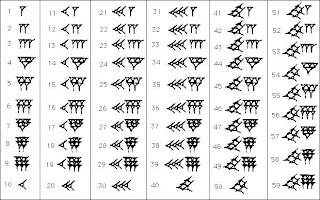A few days ago I started wondering how we determined that sixty minutes made an hour. Why wasn't the
number fifty or seventy chosen? We could have chosen any number, so how did it happen that it was
60? When we learned to count why did we pass ten and chose a higher number?
Our lives are divided into segments determined by hour units of 60 minutes each, which in turn measure 60 seconds. Our circadian sleep rhythms adjust to '
daylight saving' in springtime by moving the hands of the clock forward an hour and in the fall by moving the hands of the clock back an hour.
Our activities are determined by the 24 hours of clock time. Jobs are measured by hours spent at work. We plan school semesters around calendar days of 24 hours. Television programing is scheduled in hours of clock time.
My knowledge of math is shallow at best, but at some time in my past, I learned that zero did not exist in ancient numbering systems, but does that fact have anything to do with
The Big Six O? It's a mystery to me. So... I did what computer users do...I went to the internet to search for the answer. I googled.
There are bones and other artifacts with cuts in them suggesting tally marks that date back to 30,000 BC, but the beginning of counting is speculative. The invention of
number forms occurred in India and transmitted thru Arab cultures into Europe.
The
Babylonian numbering system started about 1800 BC but it was developed from the much older Sumerian civilization. Babylonians used only two symbols representing the number one and number ten. They did not have a zero.
They used two ones for 2, three ones for 3, four ones for 4, etc. They could use these two symbols to count to 59 but the number 60 looked like the number 10. The Babylonians never had a symbol for zero, but they used the idea of zero by leaving a blank area or space or a small wedged apostrophe between number characters. Using only two symbols, Babylonians could represent any whole number, however big.
 |
| Babylonian numerals |
We use nine characters, plus the symbol for zero. We do not have a symbol for ten.
They developed a
positional system listing numbers in columns with the power of 60 rather than ten like we use. Base 60 is a very good system. Many numbers will divide into it, 2 3 4 5 6 10 12 15 20 30. We use base 60 for hours, minutes, degrees in a circle, etc.
Phoenicians who
originally used cuneiform script later invented the alphabet which is the
basis of our modern alphabet.
Our modern numbers derive from the
Hindu–Arabic numeral system. The designs of the numbers have changed over time to the ones we currently use.
 |
| 1 |
 |
| 2 |
 |
| 3 |
 |
| 4 |
 |
| 5 |
 |
| 6 |
 |
| 7 |
 |
| 8 |
 |
| 9 |
 |
| 0 (zero) |











No comments:
Post a Comment